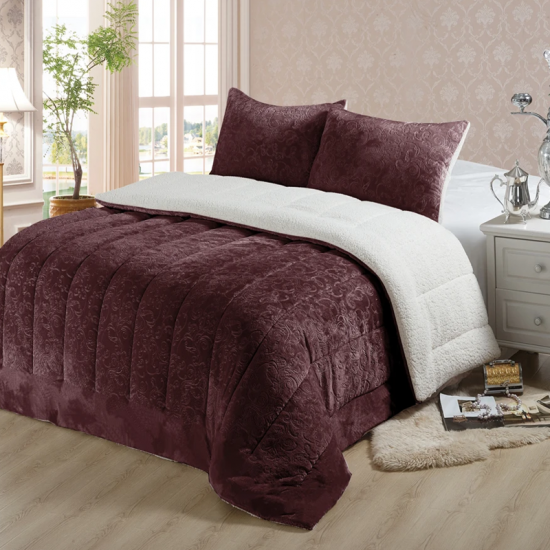Microfiber flannel blankets are often softer and warmer than traditional cotton or wool blankets due to the unique properties of microfiber and the manufacturing processes used to create them. Here’s how these factors contribute to the softness and warmth of microfiber flannel blankets:
Microfiber Composition
Extremely Fine Fibers: Microfiber is made from synthetic materials like polyester or nylon, with fibers that are much finer than natural fibers like cotton or wool. The fibers are typically less than one denier in diameter, meaning they are finer than a strand of silk. This fine structure creates a smoother, softer texture that feels luxurious against the skin.
Dense Fiber Arrangement: The high density of microfiber fibers allows the fabric to have a plush feel, which contributes to its softness. This dense arrangement also helps trap air, enhancing the blanket's warmth.
Brushed Surface Finish
Brushing Process: Microfiber flannel blankets undergo a brushing process where the fabric is gently rubbed to raise the fibers, creating a fluffy, fuzzy surface. This process makes the blanket feel even softer to the touch by increasing the surface area that comes into contact with the skin.
Double-Sided Brushing: Some microfiber flannel blankets are brushed on both sides, giving them a uniformly soft texture and increasing the insulation properties by trapping more air.
Thermal Insulation Properties
Efficient Heat Trapping: Microfiber has excellent thermal insulation properties because the fine fibers trap air between them, which acts as an insulating layer. The trapped air reduces heat loss, helping the blanket retain warmth more effectively than some natural materials.
Lightweight Warmth: Even though microfiber is lightweight, the high surface area-to-volume ratio of the fine fibers allows it to retain warmth without the bulk. This makes microfiber flannel blankets feel warmer for their weight compared to thicker cotton or wool blankets.
Moisture-Wicking Capabilities
Quick Drying: Microfiber is designed to be moisture-wicking, meaning it can draw moisture away from the body. This property helps keep the blanket and the person using it dry and warm, even in cooler conditions. Cotton tends to absorb and hold onto moisture, which can make it feel colder when damp.
Less Moisture Retention: Because microfiber doesn’t absorb as much moisture as natural fibers like cotton or wool, it helps maintain a consistent level of warmth and prevents the blanket from feeling clammy or cold.
Less Prone to Allergens
Hypoallergenic Properties: Microfiber is generally less likely to harbor dust mites and other allergens compared to natural fibers, which can help maintain a consistent softness and comfort level over time. Wool, in particular, may cause irritation for some people due to its coarser fibers.

Manufacturing Customization
Engineered Fibers: Microfiber can be engineered to have specific properties, such as enhanced softness or increased warmth, by altering the thickness, length, and arrangement of the fibers. This customization is more challenging with natural fibers, which have inherent limitations.
Blending with Other Materials: Sometimes, microfiber is blended with other synthetic fibers like spandex for added stretch or with additional finishing processes that make the fabric even softer and fluffier.
Comparisons with Cotton and Wool
Cotton Blankets: While cotton is soft and breathable, it lacks the fine, dense structure of microfiber that allows for the same level of warmth and softness. Cotton fibers are thicker and less insulating, and cotton blankets can feel heavy without providing the same warmth-to-weight ratio as microfiber.
Wool Blankets: Wool is naturally warm and can be very soft, but the fibers are typically coarser than microfiber. While wool has good insulation properties, it can sometimes feel scratchy or rough compared to the smoothness of microfiber flannel. Wool also absorbs more moisture, which can make it feel less warm in humid conditions.
Durability and Consistency
Maintaining Softness Over Time: Microfiber’s synthetic composition means it is less likely to shrink or lose its shape after washing, unlike cotton or wool, which can change texture or become rougher. This durability helps microfiber flannel blankets retain their softness and warmth longer.
Less Shedding: The tightly woven microfiber structure means the blanket is less prone to shedding fibers, which can occur with wool or lower-quality cotton blankets.















.jpg?imageView2/2/format/jp2)
.jpg?imageView2/2/format/jp2)
.jpg?imageView2/2/format/jp2)
.jpg?imageView2/2/format/jp2)
.jpg?imageView2/2/format/jp2)
.jpg?imageView2/2/format/jp2)
.jpg?imageView2/2/format/jp2)

.jpg?imageView2/2/format/jp2)